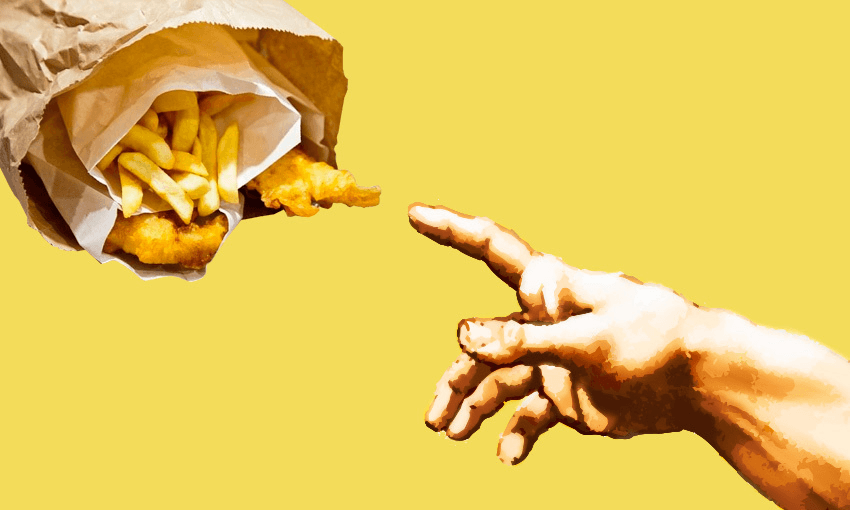The return of takeaways has become a national shorthand for the shift from level four to level three, taking on a symbolism that goes beyond the food in the box, writes Charlotte Muru-Lanning.
Apart from my habitual weekend flat white at my favourite cafe on Auckland’s Dominion Road, buying coffee made by a barista isn’t a daily necessity for me. I’m very content with my morning plunger brew.
But at the end of our first level four lockdown last year, when I joined the socially distanced queue on the footpath to order my first coffee in over a month, I felt overwhelmed with emotions. By the time I reached the front of the line I could barely remember how to speak to people outside my bubble, let alone my very simple coffee order. Granted it doesn’t take a lot for me to well up, but that morning I walked away with my tiny coffee and happy tears.
Level three takeaways seem to evoke strong emotional responses. Online comments from those excited by the prospect of takeaways in level three are often met with others who are either dismissive of or puzzled by the takeaway obsession. These range from digs at people’s supposed laziness and declaring the “level four with takeaways” label is overblown to nasty and ill-informed fat-shaming.
Long before the pandemic, takeaways, fast food especially, have drawn reactions ranging from delight to prejudice. But as we emerge from the strictest lockdown level, in a world of pervasive uncertainty, they assume an even greater symbolic weight.
Curries, Big Macs, bubble tea or whatever else is in your takeaway order represent something far more complex than these perceived assumptions of laziness or supposed unhealthy eating habits.
In a world of pervasive uncertainty, they’re symbolic of the potential of returning to normality. A small ritual comfort to hold onto when almost every single waking moment feels overwhelming. At level three a coffee is essentially a hot cup of normality.
Like it or not, we’ve been fine-tuned to feel that freedom and comfort is bound up with the ability to purchase just about anything at just about any time, income permitting. However limiting and incomplete this form of freedom might be, we’ve been told that if we can afford it, we can have it. And with the ever-growing number of delicious and diverse food options, particularly in our cities, along with the rise of food delivery apps – what might seem at first glance trivial limitations can for many come to epitomise the curtailments of a level four lockdown.
Whether it be flat whites, fish and chips, fast food or the multitudes of beautiful migrant food offerings, eating out has become a key part of the rhythms of ordinary life in Aotearoa. This is only magnified by the rise of foodie culture. Eating out can be as much about forging our own unique identities and creating communities as it is to do with filling our puku.
Level three takeaways offer a glimpse of a return to that sense of community, that culture, that normality. And that’s just as valid whether you’re joining the snaking KFC drive-through line at the first opportunity or making a dedicated effort to choose to buy takeaways from local owner-operators.
— Kereama Wright (@Rangitih1) April 21, 2020
And for many, not least parents, takeaways mean not just a reacquaintance with normality, but a respite from weeks-long ennui. After more than a month of balancing their full-time jobs with full-time childcare, takeaways offer some respite from one of the more repetitive of domestic tasks: cooking. That is unpaid, and typically female, labour. Beyond that, the possibilities of a pizza delivery or dumplings allows for an offer of novelty for children, confined to the grinding boredom of their bubbles. Meanwhile, essential workers, who have been dutifully heading to work throughout level four, now have the opportunity for a takeaway treat on their return home.
While takeaways might come as relief for some of us, take a moment to think about the people who are returning to work so you can return to a semblance of normality. For the thousands of usually low-waged workers, the return can mean anxiety as they’re faced with stressful work environments, additional risk and the pressure of relentless orders. All of us can help by being patient, maintaining distance and wearing masks – and you could even consider holding off on your orders till the lines of hungry customers inevitably ease up.
Our hospitality workforce is young. The average age of hospitality workers in New Zealand is 30, and it’s likely this average could skew even younger in restaurants and cafes. Because bookings only opened for those under 30 on September 1, many workers are unlikely to have had the chance to be fully vaccinated before returning to work this week.
For all that boxed-up food has been a beacon, a positive sign that we’re once again getting the job done, it does feel slightly different this time in Auckland.
We’re dealing with the much nastier delta variant. Case numbers are stubbornly bubbling away. All the more reason, for those of us who do choose to indulge, to diligently mask up and scan in, to get jabbed and to stick to our bubbles, with an eye on an even bigger prize: safely being together again, maybe even swapping out taking away for dining in.





